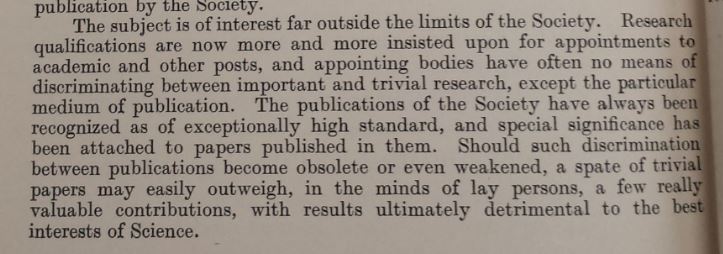“Research qualifications are now more and more insisted upon for appointments to academic and other posts, and appointing bodies have often no means of discriminating between important and trivial research, except the particular medium of publication. The publications of the Society have always been recognized as of exceptionally high standard, and special significance has been attached to papers published in them. Should such discrimination between publications become obsolete or even weakened, a spate of trivial papers may easily outweigh, in the minds of lay persons, a few really valuable contributions, with results ultimately detrimental to the best interests of Science.”
So wrote mathematician (and fellow of the Royal Society) Louis Filon, in the summer of 1936.

The Royal Society’s Publication Committee had just recommended a series of changes to the arrangements for improving the physical quality of the Society’s journals (including moving to the University Printers at Cambridge), but Filon was expressing concern about the intellectual quality of the journals. Long before the impact factor or metrics, Filon noted how useful it was for grant and appointment panels to be able to use the reputation of a journal as a proxy for the quality of its contents.
As a former vice-chancellor of University College London, Filon was well-versed in academic politics. He would have chaired plenty of committees scrutinising the CVs and publication lists of hopeful academics, and heard the arguments between academics (most of whom would not be specialists in the candidate’s field) as they tried to distinguish quality from “a spate of trivial papers”.
The context of academic politics and prestige informed the memorandum Filon sent to the Royal Society (considered at a meeting on July 9, 1936). The real point of the memo is his concern that papers published in Society’s Proceedings were no longer reliably high quality (or, as Filon puts it, “of critical importance”).
He blamed the growing amount of “routine research” produced by the growing numbers of postgraduate and postdoctoral researchers, i.e. “young and comparatively untrained men”. According to Filon, much of this work was of “secondary importance”, and would not formerly (before the Great War) have been “either offered or accepted” by the Royal Society.
Filon felt that too much of this apparently “routine research” was now being published by the Royal Society. This was increasing the bulk and cost of the publications, and also risked damaging the reputation of the Society’s journals, and hence their usefulness as markers of quality for appointment panels.
The editorial processes of the Society’s journals at this time relied entirely on the fellows of the Society. Papers had to be submitted via a fellow (a ‘communicator’), and would be refereed by one or more fellows. Filon felt that fellows who were laboratory heads were finding it “difficult to refuse the request by a student or a member of his staff to submit a paper”, and were thus failing in their duty to the Society as communicators.
He also worried that fellows acting as referees might “not unnaturally, hesitate to recommend the rejection” of a paper “vouched for by a Fellow of some reputation”.
The Society’s council presumably agreed with at least some of Filon’s concerns, for they sent a reminder to all fellows about the duties of communicators and referees, and in 1937, revised the guidance on these matters in the Society’s standing orders.
It should be noted that Filon never claimed that the allegedly “routine research” of early-career researchers should not be published. But he felt that work that was “sound so far as it goes”, or involved “the accumulation of data” or “the elaboration of minor details” should be published elsewhere, not by the Royal Society.
In the age of print and paper, this was not an unreasonable stance: the Society could not afford to publish all the “sound” work that was being produced. In the digital age, things are different, and in 2014, the Society launched Royal Society Open Science, which uses “objective peer-review” and aims to publish “all articles which are scientifically sound and useful to the community”.
Filon’s 1936 memo is one of the earliest pieces of evidence we have yet found linking editorial processes (including, but not only, the role of referees) explicitly with intellectual quality. (For an extended discussion of the roles of refereeing at the Royal Society, see Moxham and Fyfe 2017)
It is also the earliest evidence we have yet found of a recognition that journal brand or reputation was being used as a proxy for the quality of the papers published in it. (The Journal Impact Factor was not launched until 1975, see Archambault and Lariviere 2009).
Historical source reference: Royal Society Council Minutes, vol. 14, 9 July 1936.

Many thanks for this, Aileen. This is most interesting. I think the key words in your informative answer are “increasingly formalised reward/recognition systems”. In historical terms, this would mean looking for signs of a “system” appearing, and then, within the context of this “system”, what shape the “formalised” process would take. Finally, all this would help define some kind of scale where the word “increasingly” would also begin to take meaning. In short, this is a fascinating research programme. And you are probably the person best placed to undertake it (at 75, I have to be a bit more realistic… 🙁 ).
Interesting conversation! I think it is worth taking a broader view of editorial quality by which I do think there was a general sense even back in the eighteenth century that particular editorial procedures (e.g. those associated with academies and some societies) were connected to the prestige of a particular form of publishing. I also think that the idea exists by the mid-19th century (at least among some actors) that the prestige of publishing in the Phil Trans (and various other society publications) is related to the complex acceptance procedures in force there. (The idea is already implicit, it seems to me, in the normative critiques launched by Grandville in 1830 that I discuss in my book.) *But* that does not mean that the prestige of these society publications was actually strongly connected to a particular referee procedure. (Actors’ justification of their judgments about prestige might simply be that: justifications of strongly-held determinations of value derived from elsewhere. Referee systems took on such a justificatory role very quickly.) Citation-counts later became another means by which to make these kinds of justifications. But something else seems to be happening when those numerical rankings become not simply folk justifications but the basis of policy.
However, see Alex Csiszar, The Scientific Journal: Authorship and the Politics of Knowledge in the Nineteenth Century, 1 edition (Chicago ; London: University of Chicago Press, 2018), p. 36. According to Csiszar, the attempt to bolster the reputation of Phil Trans by working, for example, on its visual appearance, goes back to 1791-2. Csiszar tries to work out a reputational distinction between publication with an “Academic” look – the French Académie being the prime example of this particular forms of book crafting – vs. more commercial, more cost-conscious publications. Whether this thesis will hold, I do not know, but it does point to a reputational semiotics of book-making which, actually, has been studied by specialists of the field.
Yes, of course, it is the case that scholars in the late eighteenth and nineteenth centuries had a ‘pecking order’ of places of publication, and some types/places of publication counted more for reputation than others.
What I think is interesting about Filon’s remarks in 1936 is that:
a) they are in the context of professional academia, a world where there were career pathways and increasingly formalised reward/recognition systems. That world was related to older scholarly culture, but not the same;
b) and he explicitly mentions refereeing (and editorial selection) as being the thing that underpins the prestige of the Society’s Proceedings (i.e., it’s not the long history of the Society, or the status of its members, or the quality of its letterpress printing). I’m interested in the assumption that a particular form of editorial evaluation (one that was not yet standard or widespread) is linked to prestige. We hear it a lot now, and I’ve found other examples from the immediate post-war period, but that’s the earliest explicit link of refereeing=prestige that I’ve found so far.
You might be interested in the article Alex Csiszar has written about how (in the early days of professional academia) people got into assessing other scholars by counting their journal articles (see his ‘How lives became lists and scientific papers became data: cataloguing authorship during the nineteenth century’ https://doi.org/10.1017/S0007087417000012 ). I believe he’s now working on how this story pans out in the 20th century, which will no doubt involve the journal impact factor…!